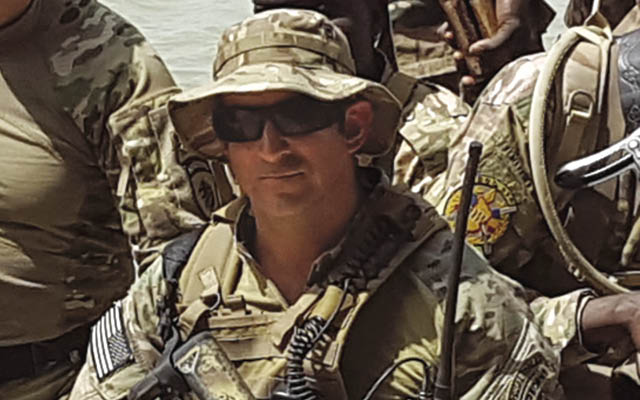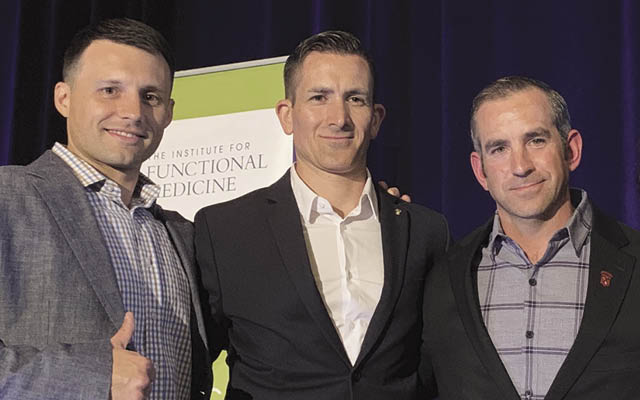Master Sergeant Geoff Dardia has a no-legs plan.
He’s served as a U.S. Army Green Beret since 2004. If he loses his legs to an explosion or gunfire, he’s prepared to build his own “robot legs” so he can stay on active duty. This is something he learned from his Special Operations colleague Chuck, who served for 10 years on a leg he designed himself. Because of the deep trust Dardia shares with his fellow soldiers, he says he sleeps better on deployment — even when that means lying under a truck, in the field, protected only by his mates — than he does back home.
The no-legs strategy isn’t his only contingency plan. After a set of mysterious symptoms nearly forced his retirement in 2012, Dardia began to arm himself with a wealth of health knowledge that has allowed him to keep serving. Today, he and a growing number of forward-thinking military healthcare providers are working to expand access to unconventional, person-centered healthcare in the military. If they’re successful, they may help prove that a whole-person approach to health is the best tool for treating those who serve — and for the rest of us, too.
Force Multiplier
Dardia was first deployed to Afghanistan in 2005. After three successful tours, he was selected to work stateside as an instructor in a specialized advanced-urban-combat school. The job involved spending several hours each day and night in indoor shoot houses or outdoor ranges, breathing in a toxic mix of heavy metals from munitions and explosives.
By 2011 he began experiencing a mysterious set of symptoms: fatigue, migraines, short-term memory loss, vision problems, brain fog, weight gain, no libido. Itchy rashes appeared on his legs. And though he was just 31, his hair was graying and falling out. His exercise and eating habits hadn’t changed, but everything else had. “I’m dragging a dead body here,” he told his doctor.
His symptoms confounded his healthcare providers. Aside from fatigue, they couldn’t offer a firm diagnosis, much less a solution. He was repeatedly told that his condition was all in his head. Some suggested PTSD, others depression. That didn’t feel right; Dardia loves his job. “The only thing I’m depressed about is not being able to do what I used to do,” he told them.
In the absence of a diagnosis, Dardia began approaching his condition as he’d been trained: He studied his environment. “What I do as a Special Forces operator is look at the threats in the environment and how they impact my operation. It’s not just me. You know, How do I interact with my environment?”
He began reading medical journals. “I got obsessed with what was killing me,” he says. He learned that his symptoms matched those of neurotoxicity and discovered what types of diagnostic testing he needed. Everything pointed to heavy-metal poisoning, as well as traumatic brain injury (TBI) and an adverse reaction to antimalarial medications.
In 2012 Dardia was finally referred for a comprehensive TBI evaluation at a high-level military hospital. His providers determined that in addition to brain injury, he had severe binocular-vision disorder (a condition in which the eyes stop working as a team), hormone dysfunction and fertility issues, leaky gut, a lesion on his pituitary gland, and white-matter lesions on his brain.
These issues were not just bad luck. Dardia had been exposed to millions of rounds of ammunition, countless explosions, and thousands of explosive charges during his military training and career.
In 2013 he and another soldier with similar symptoms met with Kevin Dorrance, chief of internal medicine at Walter Reed National Military Medical Center. Dorrance suspected lead poisoning in both men and administered bone-lead x-rays. The scans showed the two soldiers were “packed” with the toxic mineral.
One might assume that combat represents the greatest existential threat to military personnel, but most face a range of health hazards that are far less visible.
By then Dardia had begun volunteering for the Task Force Dagger Foundation (TFD), a Dallas-based nonprofit that offers support to injured Special Operations members. He knew that plenty of his fellow service members faced complex symptoms like his, so he created a program for TFD to offer “next-generation health solutions” to other Special Operations Forces (SOF) and their families.
After returning from another tour in Afghanistan in 2015, Dardia, with the help of TFD, went to Cleveland Clinic’s Center for Functional Medicine to seek treatment.
“One of the major blind spots of conventional medicine is heavy-metal toxicity,” says Mark Hyman, MD, who treated Dardia at the Cleveland Clinic. “Heavy metals are stored over time in the organs, muscles, and brain, not the blood, so blood tests won’t reveal them.”
Hyman retested Dardia and found that he was overloaded with mercury as well as lead. Genetic tests also revealed a single nucleotide polymorphism that makes it harder for his body to clear toxins.
Hyman and his team created a rigorous detoxification program to help Dardia clear the heavy metals, after rebuilding his gut and his immune system so his body would be strong enough to tolerate it. “You can’t just randomly detoxify or people get very sick,” Hyman explains. “But you can remove mercury and lead safely in a controlled therapeutic environment.”
At the Cleveland Clinic, Dardia started a supportive regimen of supplements and cleaned up his diet. His army physicians prescribed supplemental testosterone to help with his dysregulated hormones. And after four years of struggle, he started to feel better.
“It was like a fog was lifted off of me,” he recalls. “My speech, mental clarity, finding words, task organization, all that stuff . . . all the people at work noticed: ‘Hey, you’re different. You’re switched on.’”
Risk Assessment
One might assume that combat represents the greatest existential threat to military personnel, but most face a range of health hazards that are far less visible. These include hormone disruption from toxins emitted by munitions and burn pits, gut dysbiosis from prophylactic antibiotics used to protect against malaria, and tissue damage from parachute jumps and routine hikes with 70-plus-pound rucksacks.
Service members frequently suffer brain injuries from external assaults, such as traumatic knocks to the head and exposure to blast pressure waves, as well as internal forces, such as neurotoxins. Chronic pain can be a partner to all of these.
The basic conditions of military life will test the limits of any healthy person. “On average, we sleep around five, five and a half hours at a time,” explains Captain Bryan Stepanenko, MD, MPH, IFMCP. “And, in a deployed setting, these soldiers may be up all night and trying to sleep all day, with mortars, rockets, or people working where they’re trying to sleep.”
Stepanenko is an active-duty family physician at Fort Bragg in North Carolina. Trained in both conventional and functional medicine, he believes that despite the many health challenges soldiers face, there’s a lot they can do to prevent damage — and heal it when it occurs. This requires the right perspective.
Going Deep
In complex cases involving chronic pain, which are common in the military, a comprehensive case history is a vital tool. There’s typically a threshold event, Stepanenko explains, after which someone will say he or she has “never felt well since.”
“There are the emotional and the psychological stressors, but then there are the physical stressors,” he notes. “You need to understand how much stress this body had handled already, because that tells you how resilient it may be, or how close that threshold might actually be.”
A soldier he calls “Jones” (not his real name) is a case in point. Jones enjoyed a happy childhood and was active in various sports, though persistent tonsillitis meant he had to take more antibiotics than the average kid. He enlisted in the army in 2000, and seven years later was deployed to Afghanistan, where he was placed on prophylactic doxycycline, as are many deployed service members, to protect against malaria.
His job involved monitoring burn pits, which the military uses in the absence of civic sanitation services to dispose of batteries, Styrofoam cups, medical waste, plastics, computer parts, and other trash. Usually ignited with jet fuel — which contains benzene, a known carcinogen — these pits emit a stew of potent airborne toxins comparable to those encountered by 9/11 first responders.
Eight months into Jones’s deployment, his health began to suffer. It started with gut problems and acid reflux. By 2008 he was suffering from chronic sinusitis and treating it with frequent courses of antibiotics. The following year, under intense stress while training for a Special Forces qualifying course, he required emergency gallbladder surgery after executing a parachute jump wearing nearly 200 pounds of equipment.
This led to still more rounds of antibiotics, all of which were depleting an already-stressed microbiome. Jones also had trouble sleeping and suffered constant musculoskeletal pain.
Then, after deploying with the Special Forces in 2012, he suffered a minor TBI that earned him a Purple Heart. It also broke him.
“He sustained four knockouts and 40 mild TBIs prior to the straw that broke the camel’s back, which was driving a heavily armored vehicle over an IED,” recalls Stepanenko. “It didn’t flip the vehicle or anything crazy, but it was enough to where he bumped his head while wearing his helmet and he said he was ‘never the same since.’
“He had sustained exposure to antibiotics for antimalarial prophylaxis. He had sustained exposure to burn pits multiple times. He had been exposed to multiple blast overpressure events in training and on deployment, and had sustained all those head injuries. But that IED explosion was the threshold.”
In 2014 Jones was found unfit for duty after nearly 15 years of service.
A case like this could easily puzzle a conventional physician. That a minor head injury would be a breaking point doesn’t make sense on its face, yet many healthcare providers don’t have the time to learn what a body has already handled.
They do their best with what they have, and that often involves prescribing drugs for symptoms. (The Department of Defense spent an estimated $967 million on pharmaceuticals in 2017.)
By the time Jones found his way to the Cleveland Clinic in 2016, he had been placed on 44 different medications. His gut was swollen. He was in constant pain and routinely experiencing uncontrollable rage. He was anxious and depressed and contemplating suicide.
Learning what had preceded Jones’s head injury, Stepanenko says, helped providers put his crisis in context. Not only was he devastated by his medical discharge from the army, which cost him his mission and his community, he was also suffering from runaway inflammation from brain injuries and gut dysbiosis. He had a “brain on fire.”
Jones’s treatment began with an elimination diet, followed by a ketogenic food plan. His gut health improved dramatically when he avoided wheat and sugar. He received testosterone-replacement therapy because his injured pituitary gland had diminished production of the hormone. He adopted relaxation techniques and began practicing archery. He lost weight, his bloating disappeared, his anxiety and depression eased, and his cognitive function improved.
Within three years, he was off most of his medications. Chronic pain and occasional bouts of rage remain ongoing challenges, but even these are gradually dissipating.
Without understanding the root causes for his symptoms and receiving the tools he needed to heal himself, Jones would likely have continued to suffer from runaway inflammation and neuroendocrine dysfunction. The conditions would probably have worsened, possibly costing him his life. The drugs he’d been taking to control his symptoms were not enough. Yet recovery was possible for him; he just needed a different set of tools.

Geoff Dardia in 2009, serving at Zerkoh Valley, Afghanistan. This photo was taken by photojournalist David Gilkey of National Public Radio, who was killed while working in Afghanistan.
Runaway Inflammation
Brain injuries, toxic exposures, and gut dysbiosis produce a broad range of downstream effects that are typically intertwined. All can trigger runaway inflammation and systemic health problems.
Based on his own experience, Dardia worries that PTSD, while a genuine concern for many service members, is too often used as a blanket diagnosis when underlying conditions for mental-health issues might actually be physical.
“You can’t fix a problem unless you frame and identify the problem,” he says. “If you’re a person who has all these things going on and you’re just told that you have these four letters [PTSD], well, what the hell are these four letters?”
Chronic stress is itself inflammatory. When the body’s sympathetic nervous system is in fight-or-flight mode, the pituitary gland signals the adrenal glands to release cortisol. It’s a healthy hormone in the right dose; the body needs it for energy, alertness, and inflammation control.
But when the nervous system gets stuck in the sympathetic mode, as it does for many service members, the rest-and-rebuild parasympathetic system never kicks back in. The adrenals eventually give up their high alert and stop producing cortisol. Energy flatlines and inflammation skyrockets.
Chronic inflammation is often a central feature of chronic pain. For Henri Roca, MD, who treats pain patients at the VA hospital in Little Rock, Ark., addressing inflammation is a key tenet of his protocol. He also strongly emphasizes the importance of self-care for patients and empowering them to heal themselves.
“Self-care skills give the greatest chance of pain resolution,” Roca says. His patients learn to drink anti-inflammatory bone broth, which can help reduce the need for pain medication. They learn that brightly colored vegetables reduce inflammation, and that it’s important to avoid sugar, fast food, and other inflammatory fare. They’re taught gentle stretching techniques to address musculoskeletal issues.
And, crucially, they learn to give and receive support with other people in group medical appointments, a strategy that is central to Roca’s approach. The strongest motivator for a disengaged patient, he says, is “the stories of other patients who have successfully reengaged with their lives and accomplished a degree of pain resolution and acceptance.”
Each One Teach One
Marine Corps veteran Elijah Sacra is one such pain patient, and he has dedicated his postmilitary life to helping other injured service members recover their health.
He and his fiancée, Clarissa Kussin, run Warrior Wellness Solutions (WWS) in Durham, N.C., where they offer functional-medicine health coaching to active-duty service members and veterans. This includes dietary strategies to improve gut health and reduce inflammation, rehabilitative exercise, and restorative yoga and mindfulness practices.
Sacra learned the value of a lifestyle approach to managing chronic pain firsthand in 1993, when he fractured three vertebrae in his neck. “The culture of the Marine Corps at the time was ‘take some Motrin and let’s go.’ I continued to do exercises with my arms being numb,” he recalls.
Like many service members, he powered through it. But when he was honorably discharged and took a desk job in 1996, his spinal pain grew more severe. He soon changed course, pursuing a new career as a rehabilitative exercise physiologist.
As luck would have it, his first client came with a list of complex health issues that compelled Sacra to explore all the factors that contribute to a healthy recovery. That path eventually led him to study at the Institute for Integrative Nutrition (IIN) in New York City. The first military veteran to enroll there, he found himself in a strange new world.
“I’d never heard of smoothies; I’d never heard of wheatgrass,” Sacra recalls. He was still eating fast food at the time. But that began to change when he met Kussin, an IIN health coach, holistic personal chef, and meditation teacher.
In 2009 Sacra launched WWS with fellow Marine Corps veteran Alvaro Matta, and Kussin soon joined their team. “We were teaching juicing, smoothies, and some rehabilitative exercise and yoga,” he says. Sacra and Kussin attended the Functional Medicine Coaching Academy on scholarship.
The nonprofit has since provided health coaching to hundreds of service members, as well as their families and caregivers. Clients have routinely weaned themselves from their meds, lost weight, and even returned to active duty, all with the help of the dietary and lifestyle interventions they learned from WWS’s health coaches.
The team remains available to coach its clients for the rest of their lives, should they find themselves struggling with weight gain or medication. Healing complex illnesses is an ongoing process.

Dardia in 2017, serving in Chad.
The Right Tools
The Pentagon already recognizes that whole-person care is a good fit for service members. The army’s 2016 Move to Health and the VA’s Whole Health for Life initiatives place the patient at the center of the treatment model and emphasize the importance of nutrition, sleep, exercise, mindfulness, and social support. Sacra serves on a VA research advisory panel and a chronic-pain and opiate-addiction study committee.
More than 50 Department of Defense clinicians are currently certified in functional medicine. A range of integrative treatments — including acupuncture, chiropractic, biofeedback, yoga, and mindfulness — are now available to service members and veterans within the military healthcare system. Battlefield acupuncture has become a standard form of treatment for acute and chronic pain.
Still, functional and integrative services aren’t widely used at this point, and many service members aren’t aware of the available resources. Dardia, Stepanenko, and others are working to change that.
Dardia volunteers with TFD as a VA-certified recovery care coordinator to help connect people with unfamiliar integrative services. With Hyman, he’s created a pipeline for SOF to get treated at the Center for Functional Medicine. He and Stepanenko have presented on root-cause medicine to clinicians and military leaders.
Stepanenko continues to blend functional medicine into the care he provides for patients on post, and he counsels soldiers on how to protect their health during service.
“I give probiotics to guys when they go on deployment. I tell them, ‘Take your doxycycline and this. When you go over there and start breathing the air, drinking the water, and eating the local meat, take detoxifying chlorella, vitamin C, and modified citrus pectin. Drink plenty of water and make sure you’re having bowel movements daily.’”
Dardia now deploys with what he calls his “force field” supplements: glutathione to support detoxification, fish oil for inflammation, n-acetylcysteine to support lung health, and vitamin D to boost the immune system. He also packs his own high-quality paleo protein bars as one alternative to the Meals, Ready-to-Eat (MRE) rations served in the field. “I haven’t eaten an MRE since 2006,” he says.
That doesn’t mean Dardia’s immune to new health challenges. He returned from a recent deployment with severely inflamed lungs and strange skin growths. But because he understands how his body interacts with his environment, he had the team and the tools he needed to recover. (This time they included a course of antibiotics and intermittent fasting.) Nothing surprises him anymore. He’s ready for what comes.
“Everyone I know who is resilient has always had a contingency plan,” Dardia explains.
If the military’s present interest in whole-person health continues to grow, such contingencies — with nutrition, lifestyle, and social components — may eventually become one of its best defense strategies.
Dardia looks forward to seeing it. He knows that studying the “operational environment” is vital to solving any complex problem, including complex illness. In survival situations, knowledge is not just power. It’s protection.

Pictured left to right: Bryan Stepanenko, Elijah Sacra, and Geoff Dardia at the 2019 Annual Conference for the Institute for Functional Medicine in San Antonio, Texas, where they presented on chronic pain in the military healthcare system.
Get More Support
For more information about functional-healthcare resources for service members, visit:
Task Force Dagger
This link has more functional medicine-related health resources for service members:
https://www.taskforcedagger.org/
On Instagram:
@sof_health_initiative
Warrior Wellness Solutions
Health coaching services for service members and veterans:
https://www.warriorwellnesssolutions.org
Center for Functional Medicine at Cleveland Clinic
https://my.clevelandclinic.org/departments/functional-medicine
Institute for Functional Medicine
To find a functional medical physician or coach in your area, use their “find a provider” link:
https://www.ifm.org
This originally appeared as “Recovery Mission” in the January/February 2020 print issue of Experience Life.




This Post Has One Comment
Thank you for sharing. Thank you to those who took the time to listen, learn and connect the dots in health care. Our servicemen need this type of care. Because you cannot see, it or because conventional doctors do not know how to treat the issues presented it does not mean that it only in the head of the sufferers. I grieve for those servicemen and women and their families who endure years of pain and anguish after serving. Let us give them a fighting chance through functional medicine.